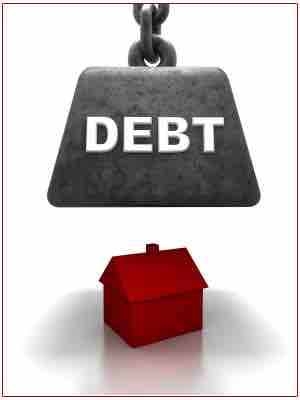Loans
Debt refers to an obligation. A loan is a monetary form of debt. A loan constitutes temporarily lending money in exchange for future repayment with specific stipulations such as interest, finance charges, and/or fees. A loan is considered a contract between the lender and the borrower. Loans may either be secured or unsecured.

Secured Loans
A secured loan is a loan in which the borrower pledges some asset (e.g., a car or property) as collateral. A mortgage loan is a very common type of debt instrument, used by many individuals to purchase housing. In this arrangement, the money is used to purchase the property. The financial institution, however, is given security — a lien on the title to the house — until the mortgage is paid off in full. If the borrower defaults on the loan, the bank has the legal right to repossess the house and sell it, to recover sums owed to it.
If the sale of the collateral does not raise enough money to pay off the debt, the creditor can often obtain a deficiency judgment against the borrower for the remaining amount. Generally speaking, secured debt may attract lower interest rates than unsecured debt due to the added security for the lender. However, credit history, ability to repay, and expected returns for the lender are also factors affecting rates.
There are two purposes for a loan secured by debt. By extending the loan through secured debt, the creditor is relieved of most of the financial risks involved because it allows the creditor to take the property in the event that the debt is not properly repaid. For the debtor, a secured debt may receive more favorable terms than that available for unsecured debt, or to be extended credit under circumstances when credit under terms of unsecured debt would not be extended at all. The creditor may offer a loan with attractive interest rates and repayment periods for the secured debt.
Unsecured Loans
Unsecured loans are monetary loans that are not secured against the borrower's assets. The interest rates applicable to these different forms may vary depending on the lender and the borrower. These may or may not be regulated by law.
Interest rates on unsecured loans are nearly always higher than for secured loans, because an unsecured lender's options for recourse against the borrower in the event of default are severely limited. An unsecured lender must sue the borrower, obtain a money judgment for breach of contract, and then pursue execution of the judgment against the borrower's unencumbered assets (that is, the ones not already pledged to secured lenders). In insolvency proceedings, secured lenders traditionally have priority over unsecured lenders when a court divides up the borrower's assets. Thus, a higher interest rate reflects the additional risk that in the event of insolvency, the debt may be difficult or impossible to collect.
Unsecured loans are often used by borrowers for small purchases such as computers, home improvements, vacations, or unexpected expenses. An unsecured loan means the lender relies on the borrower's promise to pay it back. Due to the increased risk involved, interest rates for unsecured loans tend to be higher. Typically, the balance of the loan is distributed evenly across a fixed number of payments; penalties may be assessed if the loan is paid off early. Unsecured loans are often more expensive and less flexible than secured loans, but suitable if the lender wants a short-term loan (one to five years).
In the event of the bankruptcy of the borrower, the unsecured creditors will have a general claim on the assets of the borrower after the specific pledged assets have been assigned to the secured creditors, although the unsecured creditors will usually realize a smaller proportion of their claims than the secured creditors.
In some legal systems, unsecured creditors who are also indebted to the insolvent debtor are able (and in some jurisdictions, required) to set-off the debts, which actually puts the unsecured creditor with a matured liability to the debtor in a pre-preferential position.